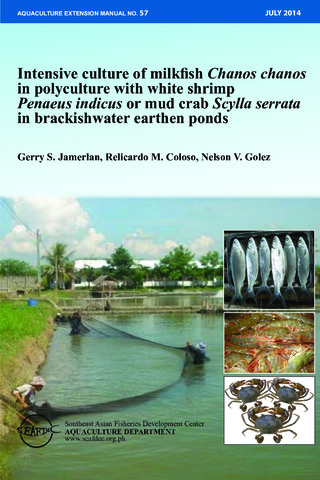Water quality and holding capacity of intensive and semi-intensive milkfish (Chanos chanos) ponds
- Global styles
- MLA
- Vancouver
- Elsevier - Harvard
- APA
- Help

View/
Date
2003Page views
1,441ASFA keyword
AGROVOC keyword
Taxonomic term
Metadata
Show full item record
Share
Abstract
This study determined the holding capacity of semi-intensive and intensive milkfish ponds and water quality in relation to fish biomass and feed input. Six units of 1000 m2 brackishwater ponds were used, three ponds for intensive system (20,000 fish ha−1) and three for semi-intensive system (8000 fish ha−1). Average production was significantly higher in intensive pond (3652 kg ha−1) than in semi-intensive pond (1352 kg ha−1) after a desired marketable size of fish was reached. Highest concentrations in effluents (mg l−1) of rearing water measured every 2 weeks were 0.369 and 0.289 for chlorophyll a (chl a), 0.485 and 0.512 for PO4–P, 0.279 and 0.811 for TAN, 0.094 and 0.082 for NO2–N, and 14.040 and 8.649 for NO3–N, 216 and 142 for total suspended solids (TSS), 15.0 and 21.7 for biological oxygen demand (BOD), in intensive and semi-intensive ponds, respectively. Lowest morning dissolved oxygen (DO) in intensive pond was 2.2 mg l−1, and did not decrease further because of aeration. In unaerated, semi-intensive pond, morning DO ranged from 1.3 to 5.0 mg l−1 but occasionally went below 1.0 mg l−1 resulting to fish mortalities at biomass of 835, 1206, and 1489 kg ha−1. Levels of NO3–N and dissolved inorganic N are linear functions of fish biomass or feed input in all systems (P<0.05). The buildup of nutrients is more pronounced at biomass of 1610 kg ha−1 and above while nutrient transformation (conversion of PO4–P or TAN to phytoplankton or vice versa) is apparent at biomass below 1419 kg ha−1. The holding capacity of unaerated, semi-intensive pond is below 1348 kg ha−1 or 54 kg feed ha−1 day−1 based on DO concentration of less than 1.0 mg l−1. However, the holding capacity can be lower than 835 kg ha−1 or 33 kg feed ha−1 day−1 during very calm weather or during rainy days when water column is stratified. Based on the results of regression analysis, the holding capacity of intensive pond should be set below 5107 kg ha−1 or 110 kg feed ha−1 day−1 so as not to exceed the acceptable levels for water quality variables in effluent waters.
Suggested Citation
Sumagaysay-Chavoso, N. S., & San Diego-McGlone, M. L. (2003). Water quality and holding capacity of intensive and semi-intensive milkfish (Chanos chanos) ponds. Aquaculture , 219(1-4), 413-429. https://doi.org/10.1016/S0044-8486(02)00576-8
Type
ArticleISSN
0044-8486Collections
- Journal Articles [1258]
Related items
Showing items related by title, author, creator and subject.
-
Historical and current trends in milkfish farming in the Philippines
This chapter focuses on the historical and current practices of milkfish farming in the Philippines. The Philippines ranks among the top 12 largest fish producers in the world and the milkfish, Chanos chanos, is the official ... -
Series: Aquaculture extension manual; No. 57
Intensive culture of milkfish Chanos chanos in polyculture with white shrimp Penaeus indicus or mud crab Scylla serrata in brackishwater earthen ponds
Jamerlan, Gerry S.; Coloso, Relicardo M.; Golez, Nelson V. (Aquaculture Department, Southeast Asian Fisheries Development Center, 2014)A 30-page extension manual describing the biology, site selection, pond management and harvest & post-harvest of milkfish intensive polyculture in earthen pond. -
AQD recommends semi-intensive milkfish culture
Sumagaysay, Neila; Baliao, Dan D.; Rodriguez, Eduard M.; Coloso, Relicardo M.; Luckstaedt, Christian (Aquaculture Department, Southeast Asian Fisheries Development Center, 1998)Details are given of a system for semi-intensive milkfish (Chanos chanos) vulture recommended by the SEAFDEC Aquaculture Department, under the following headings: 1) Pond preparation; 2) Pest (snails) control; 3) Pest ...






